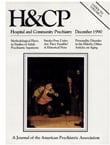Characteristics of Psychiatric Emergency Room Patients With Alcohol- or Drug-Induced Disorders
Abstract
Although emergency room psychiatrists are often faced with evaluating and planning treatment for patients who abuse substances, there is limited information about the characteristics of emergency room patients with alcohol- or drug-induced disorders. The authors describe the demographic and clinical characteristics of 343 consecutive patients referred to a general hospital's emergency psychiatry service. The 114 patients diagnosed as having an alcohol- or drug-induced disorder were younger and were more often male, unemployed, and homeless than patients with disorders not induced by substance abuse. They also demonstrated increased suicidality. Alcohol was the predominant substance that contributed to psychiatric emergencies, but a surprising number of patients were diagnosed as having amphetamine-induced disorders, possibly representing an important trend.
Access content
To read the fulltext, please use one of the options below to sign in or purchase access.- Personal login
- Institutional Login
- Sign in via OpenAthens
- Register for access
-
Please login/register if you wish to pair your device and check access availability.
Not a subscriber?
PsychiatryOnline subscription options offer access to the DSM-5 library, books, journals, CME, and patient resources. This all-in-one virtual library provides psychiatrists and mental health professionals with key resources for diagnosis, treatment, research, and professional development.
Need more help? PsychiatryOnline Customer Service may be reached by emailing [email protected] or by calling 800-368-5777 (in the U.S.) or 703-907-7322 (outside the U.S.).



